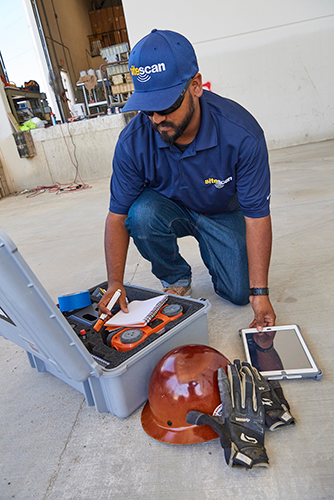Past the Surface: Leveraging Advanced Concrete Scanning Techniques for Unmatched Accuracy and Understanding
In the realm of building and construction and facilities maintenance, the mission for precision and thoroughness is never-ending. Advanced concrete scanning methods have arised as vital devices in this pursuit, providing a look underneath the surface area to reveal a world of essential insights. By using innovative technologies, experts can reveal anomalies, analyze the problem of concrete structures, and make educated choices that shape the program of tasks. The ramifications of these techniques prolong much beyond simple surface-level evaluations, guaranteeing a depth of precision and understanding that is unequaled.
Significance of Advanced Concrete Scanning
The importance of making use of advanced concrete scanning techniques depends on the unparalleled precision they provide for finding sub-surface anomalies and guaranteeing structural stability. By utilizing sophisticated modern technologies such as ground-penetrating radar (GPR), electro-magnetic induction, and progressed sonar imaging, building and construction experts can dig underneath the surface area of concrete frameworks with a degree of precision that much goes beyond standard examination approaches. Concrete Scanning. These methods make it possible for the recognition of concealed dangers like rebar rust, spaces, channels, or post-tension cable televisions that can jeopardize the security and security of a structure in time
Moreover, advanced concrete scanning gives invaluable understandings right into the general condition of a concrete aspect without the requirement for invasive steps, minimizing the threat of triggering damage throughout the analysis process. The ability to determine the precise location and deepness of potential issues enables targeted repair work and upkeep, eventually prolonging the life-span of the framework and enhancing its performance. In significance, the value of advanced concrete scanning can not be overemphasized in the realm of building and construction and facilities maintenance, where accuracy and reliability are extremely important.
Sorts Of Cutting-Edge Technologies
Anomalies and Issue Discovery

Along with GPR, concrete scanning techniques like thermography and impact-echo testing are likewise effective in finding issues and abnormalities. Thermography makes use of infrared modern technology to recognize variants in surface area temperature level, indicating potential areas of concern such as delamination or moisture ingress. On the various other hand, impact-echo testing involves analyzing acoustic reactions to find gaps, splits, and various other defects within the concrete. By leveraging these advanced techniques, specialists can proactively address architectural concerns, making certain the long life and safety and security of concrete structures.
Assessing Concrete Problem
How can designers precisely evaluate the condition of concrete structures to ensure their longevity and safety and security? Numerous sophisticated concrete scanning methods are employed for this objective. Ground-penetrating radar (GPR) is generally utilized to examine the interior framework of concrete, detecting spaces, fractures, and other abnormalities that might endanger its strength.
Additionally, visual examination remains a basic part of concrete problem analysis. Engineers aesthetically examine the surface for indicators of degeneration, such as spalling, splitting, or discoloration. Incorporating non-destructive testing techniques weblink with aesthetic assessments permits for an extensive evaluation of concrete problem, allowing engineers to recognize potential issues beforehand and apply timely maintenance or repairs. By leveraging these innovative strategies, engineers can make certain the long-term durability and security of concrete structures.
Enhancing Decision-Making Procedures
In the realm of infrastructure administration, enhancing decision-making procedures is vital for guaranteeing the efficient maintenance and durability of concrete frameworks. Boosted decision-making procedures in concrete monitoring involve using advanced scanning strategies to gather detailed information on the condition of structures. By leveraging technologies such as ground-penetrating radar and 3D imaging, stakeholders can make informed decisions regarding reinforcement, replacement, or repair techniques.
These advanced scanning techniques supply indispensable understandings right into the inner composition of concrete, determining potential issues such as spaces, cracks, or rust that might not show up externally. This level of in-depth details enables positive upkeep preparation, reducing the danger of architectural failures and boosting the total lifespan of concrete structures.
Furthermore, by integrating electronic documents and evaluation tools into the decision-making process, stakeholders can track the advancement of concrete problems in time, allowing predictive upkeep methods and optimizing resource appropriation. Ultimately, the combination of sophisticated concrete scanning techniques boosts decision-making processes by supplying unequaled precision, insight, and efficiency in framework administration.
Conclusion
In verdict, progressed concrete scanning methods supply unmatched accuracy and understanding in discovering abnormalities, defects, and assessing the condition of concrete structures. By leveraging advanced innovations, decision-making processes can be enhanced, resulting in even more informed and effective options for keeping and fixing concrete framework. These strategies play a critical function in ensuring the safety and long life of concrete structures, making them an indispensable device in the field of building and construction and engineering.
In addition, progressed concrete scanning offers invaluable understandings right into the total problem of a concrete element without my review here the need for intrusive measures, minimizing the threat of creating damages throughout the evaluation procedure - Concrete Scanning. Another ingenious modern technology is 3D X-ray scanning, which supplies detailed pictures of the interior structure of concrete, providing valuable information without the need for devastating screening. Additionally, Concrete Cover Meters are utilized to determine the density of concrete cover over support bars accurately. Enhanced decision-making processes in concrete administration entail making use of sophisticated scanning methods to gather in-depth data on the problem of structures.In final thought, advanced concrete scanning methods use unparalleled accuracy and insight in spotting abnormalities, problems, and evaluating the problem of concrete structures